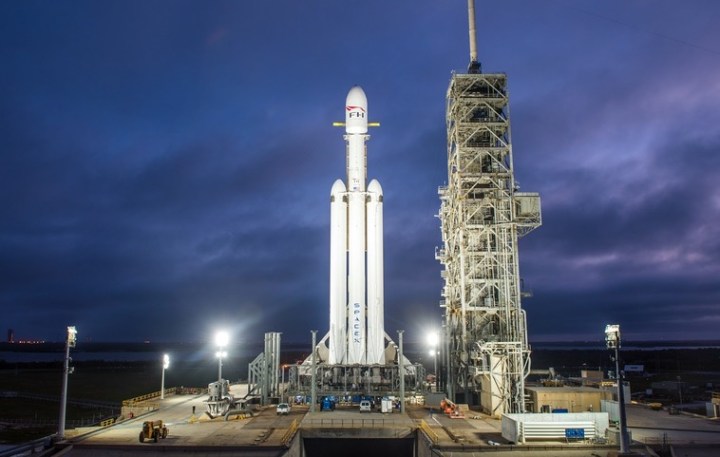
The Falcon Heavy is the largest rocket to ever come out of SpaceX, and it now has government clearance for blastoff somewhere between 1:30 and 4:30 p.m. ET on Tuesday, February 6. The 230-foot tall three-booster launcher is said to be the most powerful rocket in the world.
In addition to the actual launch, SpaceX is also trying to land all three of Falcon Heavy’s first stage cores. Per a press release, “Following booster separation, Falcon Heavy’s two side cores will return to land at SpaceX’s Landing Zones 1 and 2 (LZ-1 & LZ-2) at Cape Canaveral Air Force Station, Florida. Falcon Heavy’s center core will attempt to land on the “Of Course I Still Love You” droneship, which will be stationed in the Atlantic Ocean.”
Folks who live in the vicinity may hear “one or more sonic booms” during the landing attempts. And as for those of us who are further away, we can check out a live webcast beginning 20 minutes before launch.
The announcement of the launch is no big surprise, given that CEO Elon Musk previously tweeted that takeoff was imminent.
Falcon Heavy hold-down firing this morning was good. Generated quite a thunderhead of steam. Launching in a week or so. pic.twitter.com/npaqatbNir
— Elon Musk (@elonmusk) January 24, 2018
NASA SpaceFlight assistant editor Chris Gebhardt has also tweeted that the launch will take place on Tuesday, February 6, with a backup date of Wednesday, February 7.
Guys… are you ready!? #FalconHeavy LAUNCH DATE!
February 6th, with a backup on the 7th.
Launch time is 13:30-16:30 EST (18:30-21:30 UTC)#ItsHappening
— Chris G – NSF (@ChrisG_NSF) January 26, 2018
We’ve been waiting a long time for this — the most recent setback came during the government shutdown, as SpaceX requires support from the Air Force’s 45th Space Wing. “Due to the shutdown removing key members of the civilian workforce, the 45th Space Wing will not be able to support commercial static fires taking place on KSC,” a spokesperson for the 45th Space Wing previously said in a statement to The Verge. “Without our civilian workforce, the 45th SW is unable to support launch operations as well.”
Confirmed: No SpaceX #FalconHeavy static test fire due to government shutdown. Same goes for launches.
Statement: “Due to the shutdown removing key members of the civilian workforce, the 45th Space Wing will not be able to support commercial static fires taking place on KSC.”
— Emre Kelly (@EmreKelly) January 21, 2018
Powerful rocket system
The Falcon Heavy is essentially three Falcon 9 rockets with a single upper stage. In terms of power, it is beaten only by the Saturn V rocket that once took astronauts to the moon. Incorporating SpaceX’s tried-and-tested reusable rocket system, the Falcon Heavy’s various separation processes are designed to take place soon after launch, with all three boosters landing back on Earth. (Want to learn more? Here’s everything you need to know about the Falcon Heavy.)
But SpaceX CEO Elon Musk knows that even with the successful test, the debut mission that would follow soon after still represents a monumental challenge. He noted last year that there’s “a real good chance” the unmanned Falcon Heavy won’t even make it into orbit.
If all does go to plan, the rocket will be taking Musk’s cherry-red Tesla Roadster all the way to the red planet, where the CEO claims it could remain in orbit for a billion years. Musk earlier said he wanted to send “the silliest thing we can imagine,” adding that he loved the thought of a car “drifting apparently endlessly through space and perhaps being discovered by an alien race millions of years in the future.”
‘Beast’ of a rocket
Considering the size and power of the Falcon Heavy, it’s little surprise that Musk himself describes it as a “beast.” The first stage of the 230-foot-tall (70-meter) rocket comprises “three Falcon 9 nine-engine cores whose 27 Merlin engines together generate more than 5 million pounds of thrust at liftoff, equal to approximately eighteen 747 aircraft,” SpaceX says on its website.
While the Falcon 9 is designed for shorter missions, its big brother “restores the possibility of flying missions with crew to the moon or Mars,” SpaceX says.
In summer 2017, Musk teased the launch of the Falcon Heavy in an animation posted on Instagram, though at that time SpaceX had been hoping to launch the rocket a couple of months later. With so much at stake, however, it’s little surprise that preparations were stretched out. But now, it looks like we’re finally ready for the next phase.
Update on February 5: The Falcon Heavy is launching on February 6.
Editors' Recommendations
- Watch SpaceX fire Starship’s Raptor engines ahead of 4th test flight
- SpaceX Starlink internet heads to first cruise ships
- Watch SpaceX’s Crew Dragon thrusters guide it to space station
- How to watch SpaceX Crew-4 astronauts launch to ISS
- Check out this cool NASA image of SpaceX Crew-3’s ride home


